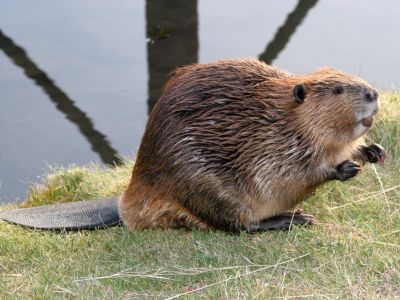Cultural Beaver Control Information
Unfortunately, there isn’t an effective beaver repellent available to keep them at bay. However, you can generally deter these critters simply by avoiding certain plants within the landscape and by clearing shrubs and trees near ponds and similar water sources. Beavers are vegetarians, feeding on small herbaceous plants and twigs. Tree bark is one of their primary food sources with cottonwood and willow trees being a particular favorite. Maple, poplar, aspen, birch, and alder trees are also high on their list of favorites. Therefore, clearing the property of these trees can significantly cut down on beaver numbers. Sometimes beavers will feed on cultivated crops as well, like corn, soybeans, and peanuts. They may even damage fruit trees. Locating these plants at least a hundred yards (91 m.) or more away from water sources can usually alleviate the problem.
Control Beaver Tree Damage with Fencing
Fencing can also help protect trees and garden areas from beaver damage. This works especially well for smaller areas. Gardens, ornamental plots, and small ponds can be fenced in with woven wire mesh. This can be ½ inch (1 cm.) mesh hardware cloth or 2 by 4 inches (5 x 10 cm.) welded wire. Fencing should be at least 3 feet (91 cm.) high and buried anywhere from 3 to 4 inches (8-10 cm.) in the ground, driving metal rods in the ground to secure it in place. Individual trees can be wrapped with this fencing as well, keeping it at least 10 inches (25 cm.) or so from the tree. Another option is electric fencing. This can be achieved by adding a strand or two of electric polytape around the area about 4 to 6 inches (10-15 cm.) off the ground.
Trap Beaver, Stop Damage
Traps and snares are effective ways to capture and relocate beavers. While there are several types available to choose from depending on your particular needs, conibear traps are the most popular. These are the most effective as well. Conibear traps are generally submerged in water and set in the dam itself, near the entrance, or in front of drainpipes to lure beavers in. Snares can also be used and in many cases are usually more convenient, safer, and the least expensive option to use.
Killing Beavers
While in some states the practice of killing beavers is illegal, this option should only be done as a last resort in areas where it is legal to do so. Before attempting any form of lethal control, it is best to contact your local environmental or conservation office for beaver control information in regard to current laws and regulations. Oftentimes, they have qualified officers that can take care of relocating these animals instead of resorting to more extreme measures.
